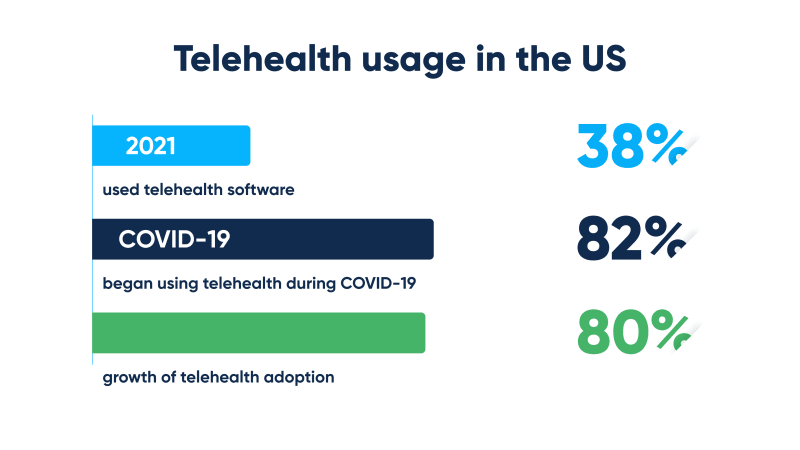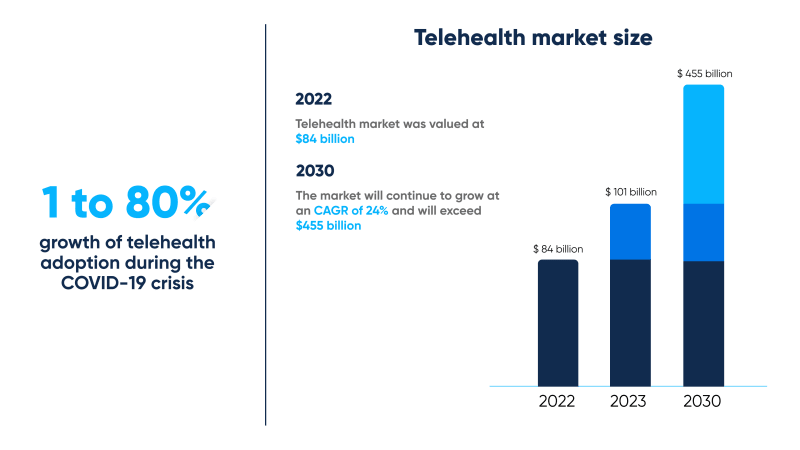This post is a quick overview of an Abto Software’s blog article.
Telehealth utilization (EHR & EMR implementation, clinical decision support, document workflow automation) is dynamically revolutionizing conventional healthcare services, which benefits both professionals and patients. Incorporated wisely, computational technology might accelerate service delivery and quality, patient recovery, employee satisfaction and retention, operational performance, and more.
Telehealth integration is gaining more momentum, and there are multiple important factors worth noting – increasing morbidity, ever faster aging population, rising prices, personnel shortage, and the COVID-19 crisis. Given the mentioned tendencies, advanced technology can streamline service delivery in many different ways.
Market tendencies: Short overview
Telemedicine advancements, beginning with audio and video appointments, ending with operational support, have been actively used even before the pandemic, but gained more popularity after the COVID-19 outbreak. Telemedicine solutions have shown noticeable potential to improve patient outcomes during the stress period and are almost indispensable these days.
The great price difference when comparing traditional and remote consultations is another influential factor. Despite some weighty roadblocks – burdensome integration, equipment maintenance, employee training – modern innovation has proven to enhance patient experience.
Telehealth segments – home- and hospital-based care
Home- and community-based care
Home- and community-based healthcare refers to medical services being delivered at the individual’s home. Telehealth services, if delivered at home, in dependence on the patient’s condition, might range from regular nursing assistance to specific medical help.
Some examples:
- Virtual appointments
- Remote monitoring
- Nutritional counseling
- Medication management and administration
- Rehabilitation assistance
- Medical education and training
Complemented by telemedicine software, home- and community-based care can benefit:
- Elderly people
- Disabled people
- Patients with chronic diseases
- Patients with terminal illnesses
Hospital-based care
Hospital-based healthcare refers to professional services being provided at state and private medical facilities. Virtual care, if delivered at the medical institution, in dependence on the patient’s condition, commonly ranges from psychotherapy to surgery, radiology, cardiology, and other narrowly focused medical fields.
Some examples:
- Virtual training and examination
- Virtual rounding and consultations
- Decision support
- Trial matching
- Electronic prescriptions
- Medical coverage
Complemented by telemedicine software, hospital-based care can provide:
- Improved accuracy and consolidation
- Enhanced decision-making and diagnosis
- Better resource-planning
- Thought-out workloads
- Reduced risks
- Increased revenue
Telehealth delivery – the four key approaches
Real-time telemedicine
Synchronous telehealth is the real-time interaction between doctor and patient through audio and video. Synchronous software is nowadays being utilized across different healthcare fields, such as emergency care, nursing and rehabilitation services, mental health, infectious diseases, and others.
The concept is simple:
- The patient first schedules an appointment
- The doctor then conducts a consultation, which might cover different healthcare services
Store-and-forward telemedicine
Asynchronous telehealth is the remote assessment and interpretation of gathered healthcare information. Asynchronous software is applied all across healthcare domains, including oncology, radiology, cardiology, ophthalmology, dermatology, and more.
The concept is straightforward:
- The patient must provide his records to the medical facility
- The doctor then assesses the record to in-depth initial analysis
- The patient receives a treatment program
- The doctor provides an additional consultation if needed
Remote patient monitoring (RPM)
Remote patient monitoring (RPM) is the purposeful utilization of specialized medical devices (for example, glucose meters, pulse oximeters, trackers, watches) to monitor and analyze the patient’s health information. The data being collected is recorded and transmitted to the centralized system, which allows medical personnel to track health indicators and detect abnormal patterns.
Mobile health
Mobile health means utilizing personal devices (smartphones, tablets) directly facilitating healthcare delivery. Some examples include guides, dietary advice, symptom tracking, and others.
Technology breakdown: Main trends to know
Integrated data sharing
Integrated data sharing includes the transmission of information between different healthcare organizations. This innovation enables professionals to access health information, which improves service delivery.
Integrated data sharing means the gathering of information from different available sources – EHRs, EMRs, medical images, test results, patient portals, social media, pharmacy systems, insurance systems, and others.
Internet of Behavior
Internet of Behavior involves the collection of information about different medical devices (trackers, watches). This advancement enables researchers to analyze geo-tagging activity, social media, and other essential factors to predict user needs.
Internet of Behavior digitizes typically manual day-to-day operations, for example appointment scheduling, treatment and medication planning, and more.
Robotic process automation
Robotic process automation (RPA) is an innovative technology that can simulate structured human activity. Explained briefly, this technology deploys scripts to handle routine processes, for example data management, transaction processing, and more.
Robotic process automation solutions are becoming more and more popular all across healthcare verticals transforming registration, appointment scheduling, payment and claims processing, data synchronization.
Human pose estimation
Human pose estimation (HPE) is a transformative technology that can accurately assess the position of joints. In brief, this technology helps identify and classify semantic points by combining computer vision and other advanced techniques.
Human pose estimation solutions enable real-time motion analysis bringing value to various healthcare fields, including rehabilitation.
How we can help
Abto Software, with expertise in delivering healthcare solutions by implementing computational technology, has the domain knowledge and experience to help healthcare businesses transform their everyday processes. Our company can deliver EHR and EMR systems, ERP and CRM solutions, RPA, HPE, and other modern tools that transform healthcare delivery across verticals.
We understand the value of transformation in the healthcare industry and help strategic-thinking leaders achieve better operational performance.
Our expertise:
- Artificial intelligence
- Computer vision
- Big data and analytics
- Blockchain technology
Our projects:
- AI based pose detection and analysis for remote MSK rehabilitation
- A platform for accelerated child abuse tracking, investigation & reporting
- A reliable ERP platform for efficient business planning and optimization
- A flexible EMR system for streamlined data management









Top comments (0)